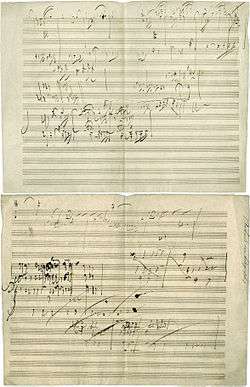Piano Sonata No. 28 (Beethoven)
Ludwig van Beethoven's Piano Sonata No. 28 in A major, Op. 101, was written in 1816 and was dedicated to the pianist Baroness Dorothea Ertmann, née Graumen. This sonata marks the beginning of what is generally regarded as Beethoven's final period, where the forms are more complex, ideas more wide-ranging, textures more polyphonic, and the treatment of the themes and motifs even more sophisticated than before. Op. 101 well exemplified this new style, and Beethoven exploits the newly expanded keyboard compass of the day.

Movements
This piano sonata consists of four movements:
- Etwas lebhaft, und mit der innigsten Empfindung (Somewhat lively, and with innermost sensibility). Allegretto, ma non troppo
- Lebhaft, marschmäßig (Lively, march-like). Vivace alla marcia
- Langsam und sehnsuchtsvoll (Slow and longingly). Adagio, ma non troppo, con affetto
- Geschwind, doch nicht zu sehr, und mit Entschlossenheit (Swiftly, but not overly, and with determination). Allegro
A complete performance of the work takes about 19–22 minutes to perform.
History
As with the previous sonata, it is unclear why Beethoven wrote Op. 101. The earliest known sketches are on leaves that once formed the parts of the Scheide Sketchbook of 1815–16. It shows the first movement already well developed and notated as an extended draft in score, and there are also a few preliminary ideas for the final Allegro.
Beethoven himself described this sonata, composed in the town of Baden, just south of Vienna, during the summer of 1816, as "a series of impressions and reveries." The more intimate nature of the late sonatas probably has some connection with his deafness, which by this stage was almost total, isolating him from society so completely that his only means of communicating with friends and visitors was via notebooks.
Beethoven offered the sonata for publication in a letter to Breitkopf and Härtel on July 19, 1816, when it was still far from complete. Eventually it was sold to the local Viennese publisher Sigmond Anton Steiner, after its completion. It was published in January 1817, and would appear in public the following month after delays.
Composition

The Piano Sonata No. 28, Op. 101 is the first of the series of Beethoven's "Late Period" sonatas (although sometimes Op. 90 is considered the first), when his music moved in a new direction toward a more personal, intimate, sometimes even introspective, realm of freedom and fantasy. In this period he had achieved a complete mastery of form, texture and tonality and was subverting the very conventions he had mastered to create works of remarkable profundity and beauty. It is also characteristic of these late works to incorporate contrapuntal techniques (e.g. canon and fugue) into the sonata form.
For the first time Beethoven used the German term Hammerklavier to refer to the piano (although it was the next of his sonatas, Op. 106, that became widely known as the Hammerklavier sonata).
This was the only one of his 32 sonatas that Beethoven ever saw played publicly; this was in 1816, and the performer was a bank official and musical dilettante.[1]
Music
First movement
This movement is in A major, 6
8 time, and in sonata form. The tempo marking for the opening movement, Etwas Lebhaft und mit der innigsten Empfindung, is roughly translated as "somewhat lively and with the warmest feeling." (This term is used on the first published score but not on the autograph, which has only "Allegretto ma non troppo.[2])
Four-part harmony and contrapuntal texture is used throughout the movement. Though the sonata is marked as being in A major, Beethoven does not write any cadences on the tonic key; the exposition and development do not include a single root position A major chord. The first tonic chord in root position appears towards the end of the recapitulation. It appears once more at the end of the recapitulation, but even then is blunted by the omission of the fifth scale degree.
Second movement
The second movement is in F major, 4
4 time. The middle section is in B♭ major. It takes the form of a march in ternary form, and is characterized by dotted rhythms, harmonic dislocation and alternation between static and accelerando.
Third and fourth movement
The third movement begins with a slow introduction in A minor, 2
4 time. The opening melody of the first movement is recalled just as the introduction nears its conclusion in original tempo and meter. The finale begins without pause, and returns to the key of the first movement, in A major. It is a grand contrapuntal movement in which Beethoven explored the newest keyboard set in his command, using the lowest E (E1) on the piano near the end. This movement is the longest and most technically challenging one in the sonata.
See also
- Piano history and musical performance – Beethoven's unusual pedal direction in the third movement
References
- Joseph Braunstein, Liner notes to the Michael Ponti recording of Clara Schumann's Piano Concerto in A minor, Op. 7
- See IMSLP.
External links
- A lecture by András Schiff on Beethoven's piano sonata Op. 101
- Beethoven Piano Sonata No. 28, Op. 101, Creation history and discussion of musical content at Raptus Association
- Piano Sonata No. 28: Scores at the International Music Score Library Project (IMSLP)
- Recording by Paavali Jumppanen, piano from the Isabella Stewart Gardner Museum